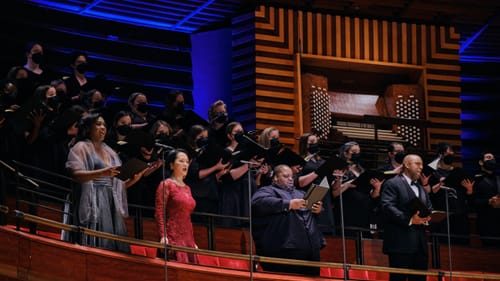Stay in the Loop
BSR publishes on a weekly schedule, with an email newsletter every Wednesday and Thursday morning. There’s no paywall, and subscribing is always free.
Finding joy in troubled times
The Philadelphia Orchestra and the Philadelphia Symphonic Choir present Beethoven’s Ninth

Yannick Nézet-Séguin and the Philadelphia Orchestra were joined by the Philadelphia Symphonic Choir and a quartet of distinguished soloists last weekend in a spectacular performance of Beethoven’s Ninth Symphony. Conducting without a score, Nézet-Séguin seemed liberated as never before to bring us what I call “Beethoven for Americans,” an approach to the popular symphony full of unbridled power, excitement, and irrepressible hope.
The last time I heard this orchestra perform the Ninth was under the stars at the Mann followed by an impressive battery of fireworks. But this performance did not need special effects. The fireworks were in the music, and Nézet-Séguin was the oxygen that fanned the flame.
Decibel power
This was not, however, a performance for picky cognoscenti. The decibel level of the timpani, for example, sometimes overshadowed Beethoven’s unforgettable melodies and original harmonies, including that shocker at the opening of the fourth movement. It’s only four notes, but what an impact those notes make when shouted out by the brass and woodwinds. I would have loved to have heard them.
And another example: the quartet of singers—all fine artists in their own right—needed a little more rehearsal to capture the seamless flow and consistent volume that should make their last vocalization the culmination of the entire symphony. However, each individual performance was on point.
Never out of fashion
The Ninth is justly famous for that precedent-setting final movement, which includes a chorus singing Beethoven’s setting of the “Ode to Joy,” inspired by a poem by Friedrich Schiller. Beethoven came across the poem in the 1790s when he was in his 20s but did not complete his Ninth Symphony until 1824, when he was 53. A fierce critic of tyrants and a vocal proponent of liberty and equal rights, Beethoven was deaf when he co-conducted the premiere in Vienna, Austria, with Michael Umlauf, a well-known conductor and composer at the time. At the end, Beethoven could not hear the audience behind him, so one of the singers turned him gently around to accept the thunderous applause.
Fashions in music come and go, but the Ninth remains a perpetual favorite around the world. This performance by the Philadelphia Orchestra grabbed listeners right from the opening measures, Nézet-Séguin leading with broad, sweeping gestures, as if awakening and drawing forth the orchestra’s powers. During the Friday matinee, the conductor seemed to enter a state of trance that persisted throughout all four movements, evoking music as a spiritual ritual.
Let’s face it: some listeners would just as soon skip the first three movements and cut to the joy-filled finale, but this is impossible in Nézet-Séguin’s realization of the score. His elevation of each of the first three movements proceeded with alacrity as well as insight, telling a compelling tale that moved inevitably from one chapter to the next. By internalizing the entire symphony, not just its jubilant conclusion, Nézet-Séguin avoided visual distractions that separate performers and audience from the larger meaning and allowed us to approach the music with our hearts as well as our intelligence.

Joining him in presenting an energizing rendition of the Ninth were four soloists: soprano Angel Blue, mezzo-soprano Mihoko Fujimura, tenor Limmie Pulliam, and bass-baritone Ryan Speedo Green; and the Philadelphia Symphonic Choir under the direction of Ryan Brandau. Pulliam, a rising star in the world of opera, stepped in at short notice, delivering a ringing performance as tenor solo.
A fitting introduction
The concert began with composer-in-residence Gabriela Lena Frank’s Pachamama Meets an Ode, a short work of tremendous power and lyricism commissioned by the orchestra. Several composers have created brief selections to be played prior to Beethoven’s Ninth, but this is the most dramatic and evocative that I have heard, making full use of the orchestra’s resources during its 10-minute length. The chorus kicks right in after a few seconds of a shimmering orchestral dissonance. A haunting motif in the oboe, then the flute, summon images of the rainforest, which is part of the composition’s climate-change theme, voiced by a composer whose heritage spans three continents. The work is a fitting introduction to Beethoven’s musical admonition to overcome the barriers that divide us and discover joy even in these troubling times.
What, When, Where
The Philadelphia Orchestra presents Gabriela Lena Frank’s Pachamama Meets an Ode and Beethoven’s Ninth Symphony in D minor, op. 125 (“Choral”). Conducted by Yannick Nézet-Séguin. Angel Blue, soprano; Mihoko Fujimura, mezzo-soprano; Limmie Pulliam, tenor; Ryan Speedo Green, bass-baritone; and the Philadelphia Symphonic Choir under the direction of Ryan Brandau. June 3-5, 2022 at the Kimmel Cultural Campus’s Verizon Hall, 300 S. Broad Street, Philadelphia. (215) 893-1999 or philorch.org.
The Kimmel Cultural Campus requires all patrons aged five years or older to be fully vaccinated against Covid-19. Masks are required at all times inside the concert hall. Seating is not distanced.
Accessibility
The Kimmel Cultural Campus is an ADA-compliant venue. Patrons can purchase wheelchair seating or loose chairs online by calling Patron Services at (215) 893-1999, or by emailing [email protected]. With advance notice, Patron Services can provide options for personal care attendants, American Sign Language, Braille tickets and programs, audio descriptions, and other services.
Sign up for our newsletter
All of the week's new articles, all in one place. Sign up for the free weekly BSR newsletters, and don't miss a conversation.

 Linda Holt
Linda Holt